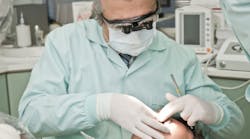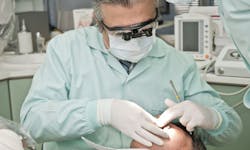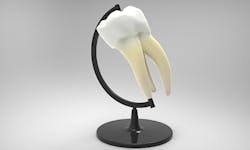Using laser technology to treat periodontal diseases
This article originally appeared in Dental Assisting Digest e-newsletter. Subscribe to this informative monthly ENL designed specifically for the dental assistant here.
Lasers are used in numerous medical fields, including general dentistry. They are extremely focused light beams that can be used to alter or remove tissues in small amounts. Dentists use lasers in many different procedures inside of the mouth. Lasers can be used to remove overgrown tissues, whiten teeth, or reshape the gums.
_________________________________________________________________________________________________________-
How laser technology can treat periodontal disease
Periodontal or gum disease is an infection of the supporting tissues and bone that hold the teeth in place. Generally affecting adults in their 30s and 40s, periodontal diseases are caused due to a number of reasons, such as poor oral health, genetic susceptibility, chronic illnesses like diabetes, smoking, and certain medications.
Typical treatment for periodontal disease is scaling and root planing (SRP). This is a nonsurgical method that includes cleaning the surfaces of teeth and their roots, which may be exposed due to gum recession.
Laser treatment is a tissue-preserving, regenerative, and bone-building procedure. In general dentistry, the dentist uses a laser to access an infected pocket to kill the infected tissue and bacteria. Once the infected tissue is removed and the root is exposed, the calculus is removed with an ultrasonic root cleaner instead of scraping with hand tools. Lastly, laser energy is used to warm the stem cell that contains blood in the pocket, which creates a seal of tissues against the tooth root.
Laser treatment ensures that no tissue is subtracted or gum tissue is reduced to a lower level on purpose. It also stimulates stem cells in the tissues to form new connective tissues, bone, and collagen. The body’s healing process then regenerates the lost ligaments and bone around the tooth.
6 benefits of laser technology for gum disease treatment
1. Limits bleeding
Numerous gingivitis patients suffer from severe gum bleeding and bone loss. Therefore, it’s critical to remove bacteria from the teeth and gingival pockets. Lasers provide the benefit of not only removing the bacteria but also killing them. This helps reduce bleeding and swelling of gums. It may even eliminate the need for further gum disease treatment such as gum surgery.
2. Can be optimized for patients
Based on the varying levels of periodontal disease, the wavelengths and power levels of the laser beam can be adjusted. This gives dentists ultimate control over the procedure and allows them to provide a dental treatment that is uniquely designed for individual patients and their long-term requirements.
3. Shorter healing time
Laser treatment causes little trauma to the gum, tooth, and surrounding areas. This means healing time is drastically reduced compared to traditional surgery. Patients will recover quicker and the whole process will be much faster.
4. Minimally invasive
Lasers are less invasive and eliminate the need for drills. This reduces the pressure that patients feel, which means there’s little or no need for anesthesia. The overall result is less pain and discomfort for patients. With minimal discomfort, patients will feel less anxious and relaxed during treatment.
5. Preserves healthy parts of the teeth
Since laser treatments are extremely precise, the technology can be used to preserve the healthy parts of the teeth while removing cavities. For patients with severe bacterial infections, preserving any healthy teeth will help ensure stronger outcomes in the long run.
6. Minimizes risk of bacterial infection
Because there are not multiple tools in use for a procedure, lasers help in sterilizing the area you work in and lower the risk of bacterial infections. Laser therapy helps offer better clinical results with shorter treatment times while reducing discomfort and the need for more invasive therapies. You can do this treatment with traditional surgeries or as a stand-alone treatment. You can make this decision based on the type and extent of the periodontal disease.
For the most current dental assistant headlines, click here.
For the most current dental headlines, click here.
References
● https://www.thedentalgeek.com/2013/06/the-benefits-of-using-lasers-to-treat-gum-disease/
● https://www.aegisdentalnetwork.com/cced/2012/05/laser-technology-its-role-in-treating-and-managing-periodontal-disease
● https://www.123dentist.com/laser-dentistry-what-is-laser-dentistry/
● http://www.dentistryiq.com/articles/2010/01/using-laser-technology.html



